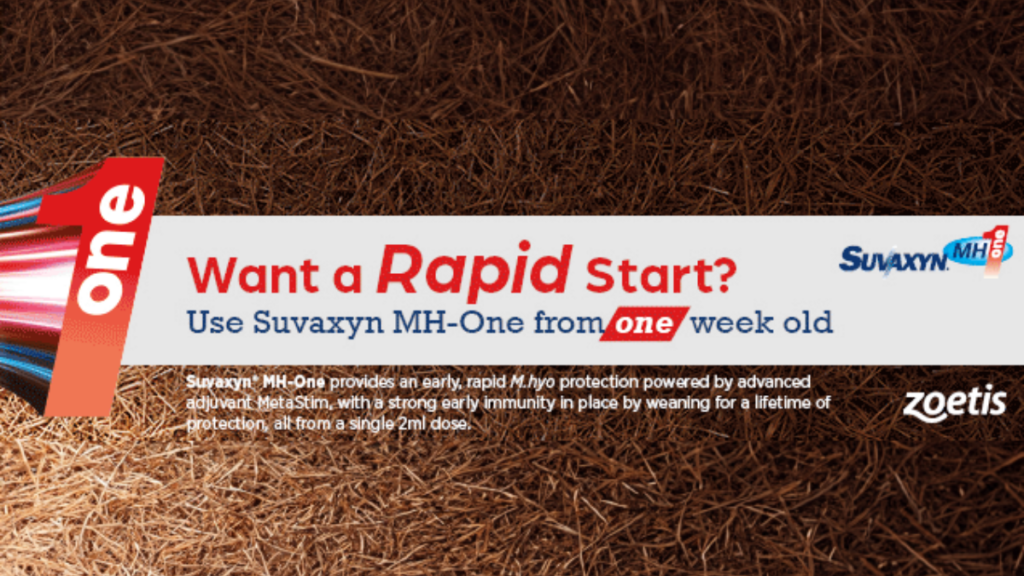An estimated 80% of the world’s pigs are positive for M.hyo, so it’s a pathogen we should be well versed in managing. As a solo pathogen M.hyo, also referred to as Enzootic Pneumonia or EP, will cause mild to moderate coughing, but when combined with other pathogens it can contribute to severe respiratory disease, production losses and mortality.
HOW DOES M.HYO CAUSE DISEASE?
The M.hyo bacteria attach to the lining of the respiratory tract, specifically to the hair like cells, called cilia. The job of the cilia cells is to sweep mucus, dust, and pathogens out of the respiratory tract by beating rhythmically ‘wafting’ debris up the trachea to be coughed out.
However, when M.hyo are present these cilia cells will clump together meaning they cannot function properly to clear the airways. This means debris and pathogens can accumulate in the lungs causing pneumonia.
M.hyo has also been shown to affect the pig’s immune system; the compromise to the lung clearance system, partnered with the effects on the immune system mean that M.hyo synergises with other pathogens, such as PRRS or Influenza, to create a very impactful respiratory disease.
WHEN WILL A PIG BE INFECTED BY M.HYO?
The original source of infection for a group will be the farrowing house. M.hyo isn’t a latent or persistent infection (it doesn’t stay in a pig forever), however the literature demonstrates that positive animals can transmit the bacteria for 200 days after their own infection (Pieters et al. 2009); so, gilts and first parity sows may be shedding the bacteria when they are farrowing, infecting their litters and being the original source of infection for the feeding herd.
At the point of weaning there may only be a small proportion of litters that are positive for M.hyo, but when litters are mixed M.hyo will spread around the group, although transmission can be slow and unpredictable, meaning coughing doesn’t acutely start and stop in the group but is more likely to present as fluctuating coughing through growing and finishing.
CONTROLLING M.HYO
Vaccination
Vaccination is the best tool we have for minimising M.hyo lesions in an M.hyo positive herd. These vaccines may be combined with PCV2 in a one-shot formulation (e.g. CircoMax Myco), may be a ‘straight’ one dose M.hyo vaccine (e.g. Suvaxyn MH-One) or a two shot ‘Prime-Boost’ M.hyo vaccine (e.g. Suvaxyn M.hyo). Discuss with your vet the best M.hyo vaccination approach for your herd.
Gilt Management
Proper control of M.hyo in growing and finishing will not be achieved if gilt management in the breeding herd is not optimal. Gilts could be shedding M.hyo up to 200 days after they are first infected, so gilts should be exposed to the FARM’S OWN STRAINS of M.hyo 200 days before they are due to farrow for the first time (around 90 days pre-breeding), this means that gilts should be delivered at less than 90 kg for acclimation to allow exposure, which can take 1 to 30 days after entry.
Bringing in M.hyo positive gilts does not supersede the above, as there are many different strains of M.hyo which provide varying cross protection against one another. In addition, the already positive gilts could bring a novel strain which will subsequently spread around the breeding herd meaning even older sows may start shedding to their litters.
All gilts entering a M.hyo positive herd should be vaccinated against M.hyo, as this will reduce the lung lesions produced by infection, but unfortunately none of the vaccines will prevent the colonisation occurring.
Environment
The ventilation and air quality of a building can make a huge difference to the impact of M.hyo on a pig herd. As mentioned previously the bacteria compromises the clearance of debris from the lungs allowing it to settle and cause pneumonia. Keeping an environment clean and well-ventilated can improve respiratory health and production.
M.hyo Control Options in the Zoetis Vaccine Range:

Suvaxyn® MH-One Emulsion for injection for pigs contains inactivated Mycoplasma hyopneumoniae, strain P-5722-3. POM-V. Suvaxyn® M.hyo Suspension for injection for pigs contains inactivated Mycoplasma hyopneumoniae, strain P-5722-3. POM-V. CircoMax® Myco contains inactivated recombinant chimeric porcine circovirus type 1 containing the porcine circovirus type 2a open reading frame 2 (ORF2) protein, inactivated recombinant chimeric porcine circovirus type 1 containing the porcine circovirus type 2b (ORF2) protein and inactivated Mycoplasma hyopneumoniae, strain P-5722-3. POM-V. Use medicines responsibly (www.noah.co.uk/responsible).
Further information can be obtained from the product SPC or from Zoetis UK Limited, 1st Floor, Birchwood Building, Springfield Drive, Leatherhead, Surrey, KT22 7LP. www.zoetis.co.ukCustomer Support: 0345 300 8034. Date of preparation: April 2024. MM- 33548
Reference: Pieters M, Pijoan C, Fano E,. An assessment of the duration of Mycoplasma hyopneumoniae infection in an experimentally infected population of pigs. Vet Microbiology 2009;134:261-266.




